Hongjiang Wei
Low-Rank Augmented Implicit Neural Representation for Unsupervised High-Dimensional Quantitative MRI Reconstruction
Jun 10, 2025Abstract:Quantitative magnetic resonance imaging (qMRI) provides tissue-specific parameters vital for clinical diagnosis. Although simultaneous multi-parametric qMRI (MP-qMRI) technologies enhance imaging efficiency, robustly reconstructing qMRI from highly undersampled, high-dimensional measurements remains a significant challenge. This difficulty arises primarily because current reconstruction methods that rely solely on a single prior or physics-informed model to solve the highly ill-posed inverse problem, which often leads to suboptimal results. To overcome this limitation, we propose LoREIN, a novel unsupervised and dual-prior-integrated framework for accelerated 3D MP-qMRI reconstruction. Technically, LoREIN incorporates both low-rank prior and continuity prior via low-rank representation (LRR) and implicit neural representation (INR), respectively, to enhance reconstruction fidelity. The powerful continuous representation of INR enables the estimation of optimal spatial bases within the low-rank subspace, facilitating high-fidelity reconstruction of weighted images. Simultaneously, the predicted multi-contrast weighted images provide essential structural and quantitative guidance, further enhancing the reconstruction accuracy of quantitative parameter maps. Furthermore, our work introduces a zero-shot learning paradigm with broad potential in complex spatiotemporal and high-dimensional image reconstruction tasks, further advancing the field of medical imaging.
SUFFICIENT: A scan-specific unsupervised deep learning framework for high-resolution 3D isotropic fetal brain MRI reconstruction
May 26, 2025Abstract:High-quality 3D fetal brain MRI reconstruction from motion-corrupted 2D slices is crucial for clinical diagnosis. Reliable slice-to-volume registration (SVR)-based motion correction and super-resolution reconstruction (SRR) methods are essential. Deep learning (DL) has demonstrated potential in enhancing SVR and SRR when compared to conventional methods. However, it requires large-scale external training datasets, which are difficult to obtain for clinical fetal MRI. To address this issue, we propose an unsupervised iterative SVR-SRR framework for isotropic HR volume reconstruction. Specifically, SVR is formulated as a function mapping a 2D slice and a 3D target volume to a rigid transformation matrix, which aligns the slice to the underlying location in the target volume. The function is parameterized by a convolutional neural network, which is trained by minimizing the difference between the volume slicing at the predicted position and the input slice. In SRR, a decoding network embedded within a deep image prior framework is incorporated with a comprehensive image degradation model to produce the high-resolution (HR) volume. The deep image prior framework offers a local consistency prior to guide the reconstruction of HR volumes. By performing a forward degradation model, the HR volume is optimized by minimizing loss between predicted slices and the observed slices. Comprehensive experiments conducted on large-magnitude motion-corrupted simulation data and clinical data demonstrate the superior performance of the proposed framework over state-of-the-art fetal brain reconstruction frameworks.
JSover: Joint Spectrum Estimation and Multi-Material Decomposition from Single-Energy CT Projections
May 12, 2025Abstract:Multi-material decomposition (MMD) enables quantitative reconstruction of tissue compositions in the human body, supporting a wide range of clinical applications. However, traditional MMD typically requires spectral CT scanners and pre-measured X-ray energy spectra, significantly limiting clinical applicability. To this end, various methods have been developed to perform MMD using conventional (i.e., single-energy, SE) CT systems, commonly referred to as SEMMD. Despite promising progress, most SEMMD methods follow a two-step image decomposition pipeline, which first reconstructs monochromatic CT images using algorithms such as FBP, and then performs decomposition on these images. The initial reconstruction step, however, neglects the energy-dependent attenuation of human tissues, introducing severe nonlinear beam hardening artifacts and noise into the subsequent decomposition. This paper proposes JSover, a fundamentally reformulated one-step SEMMD framework that jointly reconstructs multi-material compositions and estimates the energy spectrum directly from SECT projections. By explicitly incorporating physics-informed spectral priors into the SEMMD process, JSover accurately simulates a virtual spectral CT system from SE acquisitions, thereby improving the reliability and accuracy of decomposition. Furthermore, we introduce implicit neural representation (INR) as an unsupervised deep learning solver for representing the underlying material maps. The inductive bias of INR toward continuous image patterns constrains the solution space and further enhances estimation quality. Extensive experiments on both simulated and real CT datasets show that JSover outperforms state-of-the-art SEMMD methods in accuracy and computational efficiency.
Unsupervised Self-Prior Embedding Neural Representation for Iterative Sparse-View CT Reconstruction
Feb 08, 2025

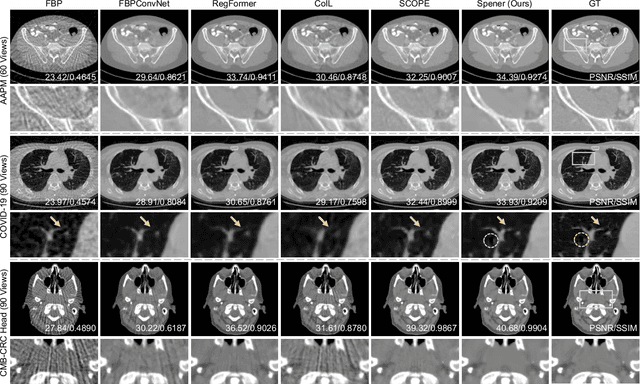

Abstract:Emerging unsupervised implicit neural representation (INR) methods, such as NeRP, NeAT, and SCOPE, have shown great potential to address sparse-view computed tomography (SVCT) inverse problems. Although these INR-based methods perform well in relatively dense SVCT reconstructions, they struggle to achieve comparable performance to supervised methods in sparser SVCT scenarios. They are prone to being affected by noise, limiting their applicability in real clinical settings. Additionally, current methods have not fully explored the use of image domain priors for solving SVCsT inverse problems. In this work, we demonstrate that imperfect reconstruction results can provide effective image domain priors for INRs to enhance performance. To leverage this, we introduce Self-prior embedding neural representation (Spener), a novel unsupervised method for SVCT reconstruction that integrates iterative reconstruction algorithms. During each iteration, Spener extracts local image prior features from the previous iteration and embeds them to constrain the solution space. Experimental results on multiple CT datasets show that our unsupervised Spener method achieves performance comparable to supervised state-of-the-art (SOTA) methods on in-domain data while outperforming them on out-of-domain datasets. Moreover, Spener significantly improves the performance of INR-based methods in handling SVCT with noisy sinograms. Our code is available at https://github.com/MeijiTian/Spener.
Unsupervised Multi-Parameter Inverse Solving for Reducing Ring Artifacts in 3D X-Ray CBCT
Dec 08, 2024
Abstract:Ring artifacts are prevalent in 3D cone-beam computed tomography (CBCT) due to non-ideal responses of X-ray detectors, severely degrading imaging quality and reliability. Current state-of-the-art (SOTA) ring artifact reduction (RAR) algorithms rely on extensive paired CT samples for supervised learning. While effective, these methods do not fully capture the physical characteristics of ring artifacts, leading to pronounced performance drops when applied to out-of-domain data. Moreover, their applications to 3D CBCT are limited by high memory demands. In this work, we introduce \textbf{Riner}, an unsupervised method formulating 3D CBCT RAR as a multi-parameter inverse problem. Our core innovation is parameterizing the X-ray detector responses as solvable variables within a differential physical model. By jointly optimizing a neural field to represent artifact-free CT images and estimating response parameters directly from raw measurements, Riner eliminates the need for external training data. Moreover, it accommodates diverse CT geometries, enhancing practical usability. Empirical results on both simulated and real-world datasets show that Riner surpasses existing SOTA RAR methods in performance.
GESH-Net: Graph-Enhanced Spherical Harmonic Convolutional Networks for Cortical Surface Registration
Oct 18, 2024Abstract:Currently, cortical surface registration techniques based on classical methods have been well developed. However, a key issue with classical methods is that for each pair of images to be registered, it is necessary to search for the optimal transformation in the deformation space according to a specific optimization algorithm until the similarity measure function converges, which cannot meet the requirements of real-time and high-precision in medical image registration. Researching cortical surface registration based on deep learning models has become a new direction. But so far, there are still only a few studies on cortical surface image registration based on deep learning. Moreover, although deep learning methods theoretically have stronger representation capabilities, surpassing the most advanced classical methods in registration accuracy and distortion control remains a challenge. Therefore, to address this challenge, this paper constructs a deep learning model to study the technology of cortical surface image registration. The specific work is as follows: (1) An unsupervised cortical surface registration network based on a multi-scale cascaded structure is designed, and a convolution method based on spherical harmonic transformation is introduced to register cortical surface data. This solves the problem of scale-inflexibility of spherical feature transformation and optimizes the multi-scale registration process. (2)By integrating the attention mechanism, a graph-enhenced module is introduced into the registration network, using the graph attention module to help the network learn global features of cortical surface data, enhancing the learning ability of the network. The results show that the graph attention module effectively enhances the network's ability to extract global features, and its registration results have significant advantages over other methods.
Coordinate-Based Neural Representation Enabling Zero-Shot Learning for 3D Multiparametric Quantitative MRI
Oct 02, 2024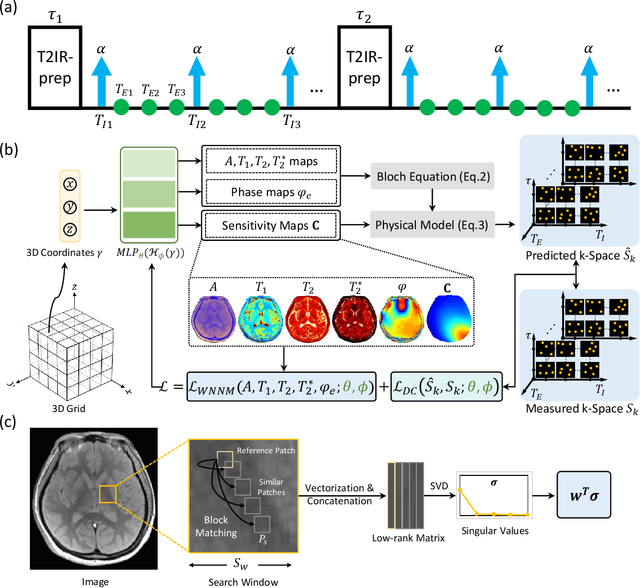

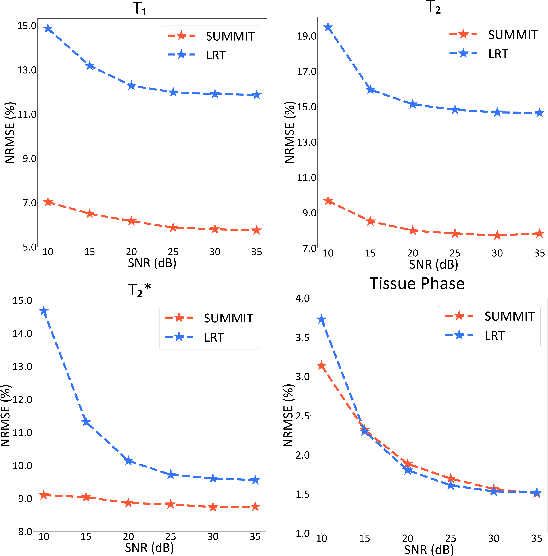
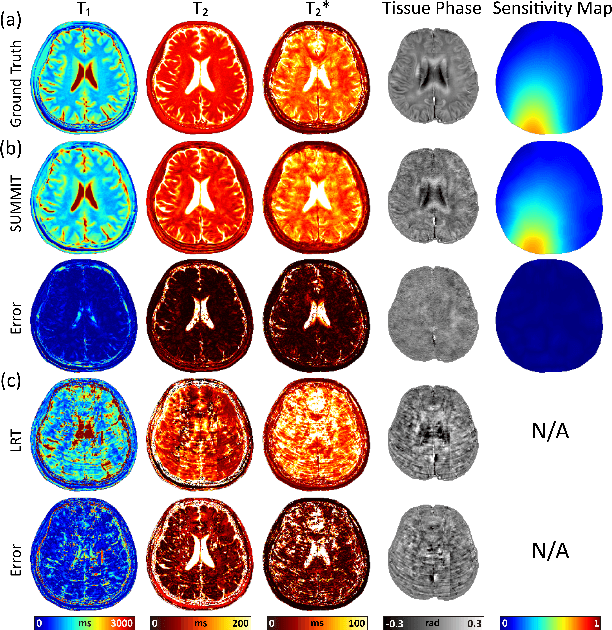
Abstract:Quantitative magnetic resonance imaging (qMRI) offers tissue-specific physical parameters with significant potential for neuroscience research and clinical practice. However, lengthy scan times for 3D multiparametric qMRI acquisition limit its clinical utility. Here, we propose SUMMIT, an innovative imaging methodology that includes data acquisition and an unsupervised reconstruction for simultaneous multiparametric qMRI. SUMMIT first encodes multiple important quantitative properties into highly undersampled k-space. It further leverages implicit neural representation incorporated with a dedicated physics model to reconstruct the desired multiparametric maps without needing external training datasets. SUMMIT delivers co-registered T1, T2, T2*, and quantitative susceptibility mapping. Extensive simulations and phantom imaging demonstrate SUMMIT's high accuracy. Additionally, the proposed unsupervised approach for qMRI reconstruction also introduces a novel zero-shot learning paradigm for multiparametric imaging applicable to various medical imaging modalities.
Moner: Motion Correction in Undersampled Radial MRI with Unsupervised Neural Representation
Sep 25, 2024



Abstract:Motion correction (MoCo) in radial MRI is a challenging problem due to the unpredictability of subject's motion. Current state-of-the-art (SOTA) MoCo algorithms often use extensive high-quality MR images to pre-train neural networks, obtaining excellent reconstructions. However, the need for large-scale datasets significantly increases costs and limits model generalization. In this work, we propose Moner, an unsupervised MoCo method that jointly solves artifact-free MR images and accurate motion from undersampled, rigid motion-corrupted k-space data, without requiring training data. Our core idea is to leverage the continuous prior of implicit neural representation (INR) to constrain this ill-posed inverse problem, enabling ideal solutions. Specifically, we incorporate a quasi-static motion model into the INR, granting its ability to correct subject's motion. To stabilize model optimization, we reformulate radial MRI as a back-projection problem using the Fourier-slice theorem. Additionally, we propose a novel coarse-to-fine hash encoding strategy, significantly enhancing MoCo accuracy. Experiments on multiple MRI datasets show our Moner achieves performance comparable to SOTA MoCo techniques on in-domain data, while demonstrating significant improvements on out-of-domain data.
Highly Accelerated MRI via Implicit Neural Representation Guided Posterior Sampling of Diffusion Models
Jul 03, 2024
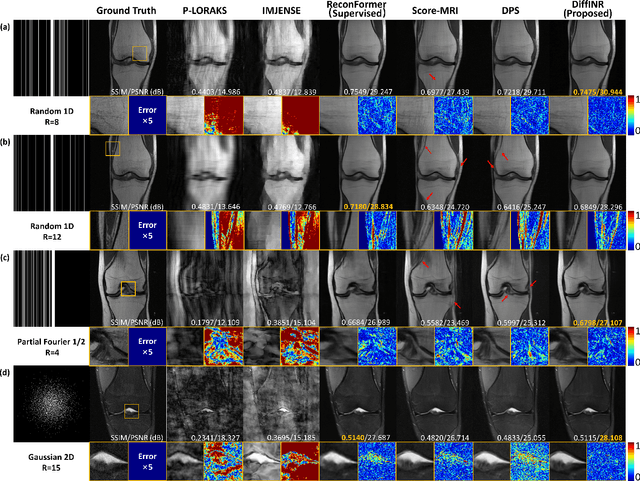
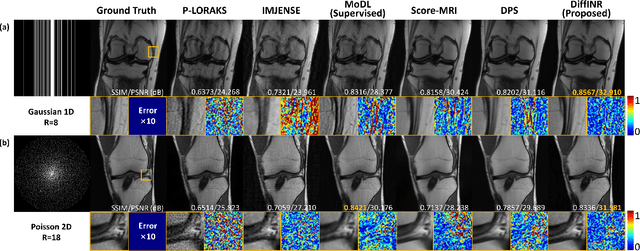
Abstract:Reconstructing high-fidelity magnetic resonance (MR) images from under-sampled k-space is a commonly used strategy to reduce scan time. The posterior sampling of diffusion models based on the real measurement data holds significant promise of improved reconstruction accuracy. However, traditional posterior sampling methods often lack effective data consistency guidance, leading to inaccurate and unstable reconstructions. Implicit neural representation (INR) has emerged as a powerful paradigm for solving inverse problems by modeling a signal's attributes as a continuous function of spatial coordinates. In this study, we present a novel posterior sampler for diffusion models using INR, named DiffINR. The INR-based component incorporates both the diffusion prior distribution and the MRI physical model to ensure high data fidelity. DiffINR demonstrates superior performance on experimental datasets with remarkable accuracy, even under high acceleration factors (up to R=12 in single-channel reconstruction). Notably, our proposed framework can be a generalizable framework to solve inverse problems in other medical imaging tasks.
Zero-Shot Image Denoising for High-Resolution Electron Microscopy
Jun 20, 2024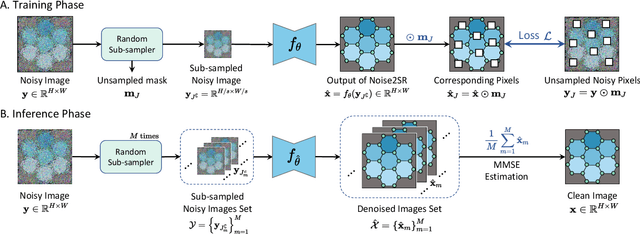
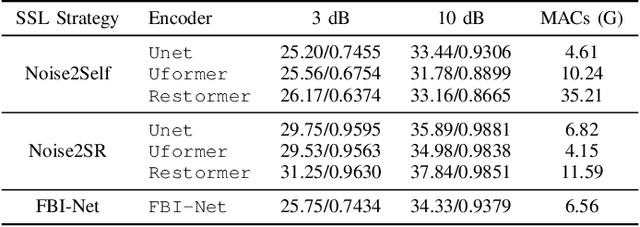
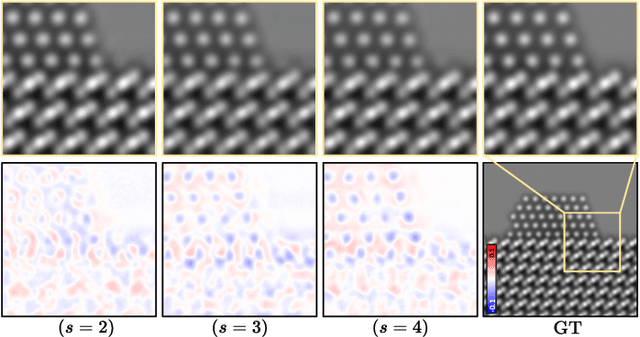
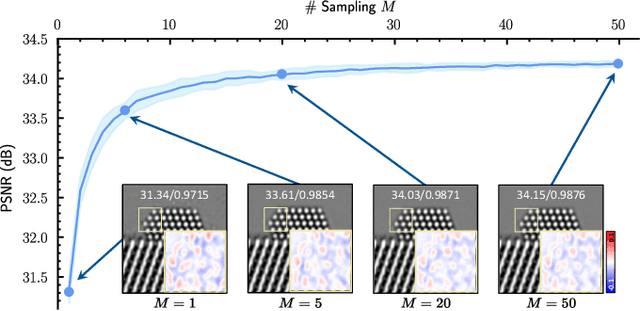
Abstract:High-resolution electron microscopy (HREM) imaging technique is a powerful tool for directly visualizing a broad range of materials in real-space. However, it faces challenges in denoising due to ultra-low signal-to-noise ratio (SNR) and scarce data availability. In this work, we propose Noise2SR, a zero-shot self-supervised learning (ZS-SSL) denoising framework for HREM. Within our framework, we propose a super-resolution (SR) based self-supervised training strategy, incorporating the Random Sub-sampler module. The Random Sub-sampler is designed to generate approximate infinite noisy pairs from a single noisy image, serving as an effective data augmentation in zero-shot denoising. Noise2SR trains the network with paired noisy images of different resolutions, which is conducted via SR strategy. The SR-based training facilitates the network adopting more pixels for supervision, and the random sub-sampling helps compel the network to learn continuous signals enhancing the robustness. Meanwhile, we mitigate the uncertainty caused by random-sampling by adopting minimum mean squared error (MMSE) estimation for the denoised results. With the distinctive integration of training strategy and proposed designs, Noise2SR can achieve superior denoising performance using a single noisy HREM image. We evaluate the performance of Noise2SR in both simulated and real HREM denoising tasks. It outperforms state-of-the-art ZS-SSL methods and achieves comparable denoising performance with supervised methods. The success of Noise2SR suggests its potential for improving the SNR of images in material imaging domains.
 Add to Chrome
Add to Chrome Add to Firefox
Add to Firefox Add to Edge
Add to Edge